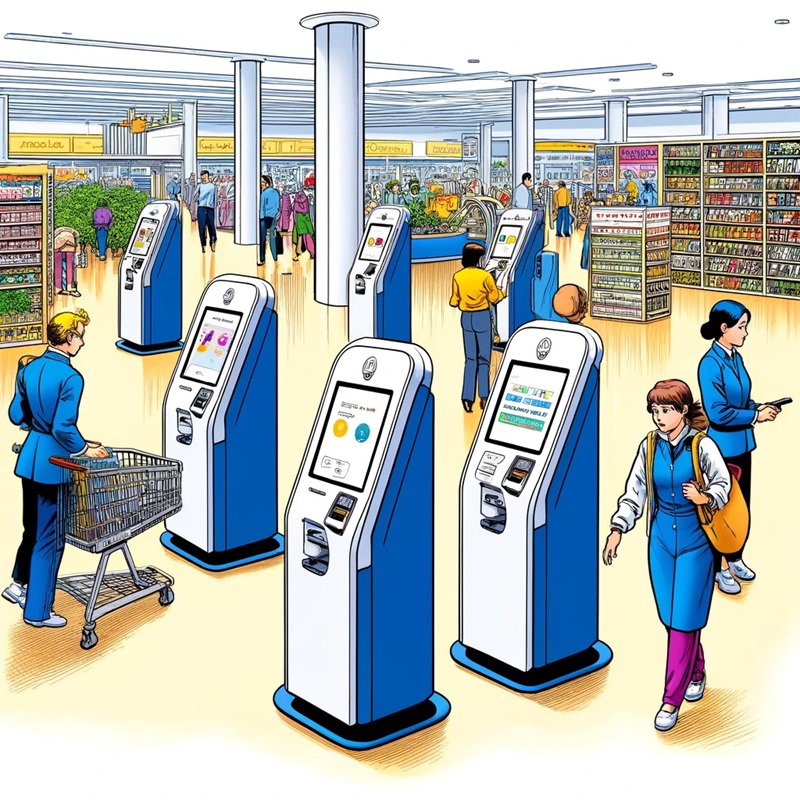
Kiosks in Retail
Retail technology continues to play a pivotal role in enhancing the customer experience and improving operational efficiency. One of the most impactful advancements in recent years is the integration of kiosks in retail settings. These versatile, interactive systems have transformed how customers shop, access information, and interact with brands. This blog post explores the various roles of kiosks in retail, from self-checkout systems to product information stations, and how they streamline the shopping experience.
Self-Checkout Systems: Revolutionizing the Checkout Process
The introduction of self-checkout kiosks has significantly revolutionized the checkout process in retail stores. These kiosks allow customers to scan, bag, and pay for their items independently, reducing wait times and alleviating congestion at traditional checkout counters. For both retailers and customers, the benefits are substantial.
Self-checkout kiosks enable retailers to increase throughput, as multiple kiosks can serve more customers simultaneously compared to a single cashier. This efficiency translates into shorter lines and faster transactions, enhancing the overall shopping experience. Additionally, by reallocating staff from checkout duties to other customer service roles, retailers can improve service levels throughout the store.
Major retail chains like Walmart and Target have successfully implemented self-checkout kiosks, reporting increased customer satisfaction and operational efficiency. These systems are particularly beneficial during peak shopping times, such as holidays and sales events, where quick service is crucial. Customers appreciate the convenience of self-checkout, especially those purchasing a few items and seeking a swift exit.
Interactive Product Information Stations
Beyond facilitating transactions, kiosks serve as valuable resources for product information. Interactive product information stations provide customers with detailed descriptions, specifications, reviews, and availability of products. This functionality empowers customers to make informed purchasing decisions without the need to seek assistance from store associates.
By integrating these kiosks with the store’s inventory management system, retailers can ensure that the information displayed is accurate and up-to-date. Customers can check if an item is in stock, locate it within the store, and even compare similar products side-by-side. This level of transparency and accessibility enhances the shopping experience, building trust and satisfaction.
Retailers like Best Buy and Home Depot use product information kiosks to great effect, allowing customers to delve deeper into product features and read user reviews. This self-service approach not only improves customer engagement but also frees up store associates to focus on more complex inquiries and personalized service.
Personalized Shopping Assistance
Personalization is a key driver of customer loyalty in today’s competitive retail environment. Kiosks equipped with personalized shopping assistance features are transforming how retailers cater to individual customer preferences. By integrating with loyalty programs and customer accounts, these kiosks can offer tailored recommendations and special offers based on past purchases and browsing history.
Artificial intelligence and machine learning play a crucial role in enhancing these personalized experiences. Kiosks analyze customer data to suggest complementary products, highlight promotions relevant to the shopper, and even offer personalized discounts. This level of customization makes customers feel valued and understood, fostering a deeper connection with the brand.
For instance, Sephora utilizes personalized shopping kiosks that allow customers to scan their loyalty cards and receive tailored beauty product recommendations. This not only enhances the shopping experience but also drives higher sales by promoting products that align with customer preferences.
Inventory Management and Stock Availability
One of the most frustrating experiences for shoppers is finding out that a desired item is out of stock. Kiosks help mitigate this issue by providing real-time inventory management and stock availability information. Customers can use these kiosks to check whether a product is available in-store, locate it on the shelves, or place an order for home delivery if it is out of stock.
By integrating kiosks with their inventory management systems, retailers can offer accurate, up-to-date information on product availability. This not only improves the shopping experience but also reduces the burden on store staff, who would otherwise need to manually check stock levels.
Retailers like IKEA have implemented kiosks that allow customers to check stock availability and even print out product location maps. This self-service approach streamlines the shopping experience, enabling customers to find and purchase products with ease.
Enhanced Customer Service and Support
Kiosks are not just about transactions and information; they also play a crucial role in enhancing customer service and support. Retailers are increasingly using kiosks to offer additional services such as wayfinding, gift registry management, and customer feedback collection.
Wayfinding kiosks help customers navigate large stores by providing directions to specific departments or products. Gift registry kiosks allow customers to create, manage, and purchase from gift registries without the need for assistance. Feedback kiosks enable customers to share their shopping experiences and suggestions, providing valuable insights for retailers to improve their services.
Innovations in kiosk technology are driving even greater enhancements in customer service. Voice-activated kiosks, for example, allow customers to interact with the system using voice commands, making the experience more intuitive and accessible. Multilingual support ensures that customers from diverse backgrounds can use the kiosks comfortably, further enhancing inclusivity.
Future trends in kiosk technology promise even more exciting developments. The integration of augmented reality (AR) could allow customers to visualize products in their home environment before purchasing, while biometric authentication could offer seamless and secure transactions.
The integration of kiosks in retail settings has undeniably streamlined the shopping experience, offering a range of benefits from faster checkouts and detailed product information to personalized assistance and enhanced customer service. As technology continues to evolve, the role of kiosks in retail will only become more integral, driving innovations that further enhance the shopping experience for customers and operational efficiency for retailers. By embracing these advancements, retailers can stay ahead in the competitive landscape, providing exceptional service and building lasting customer relationships.
Download our Vendor Selection White Paper
This white paper aims to guide businesses through the process of selecting a payment terminal vendor by examining essential considerations such as security features, integration capabilities, user experience, and cost implications.

